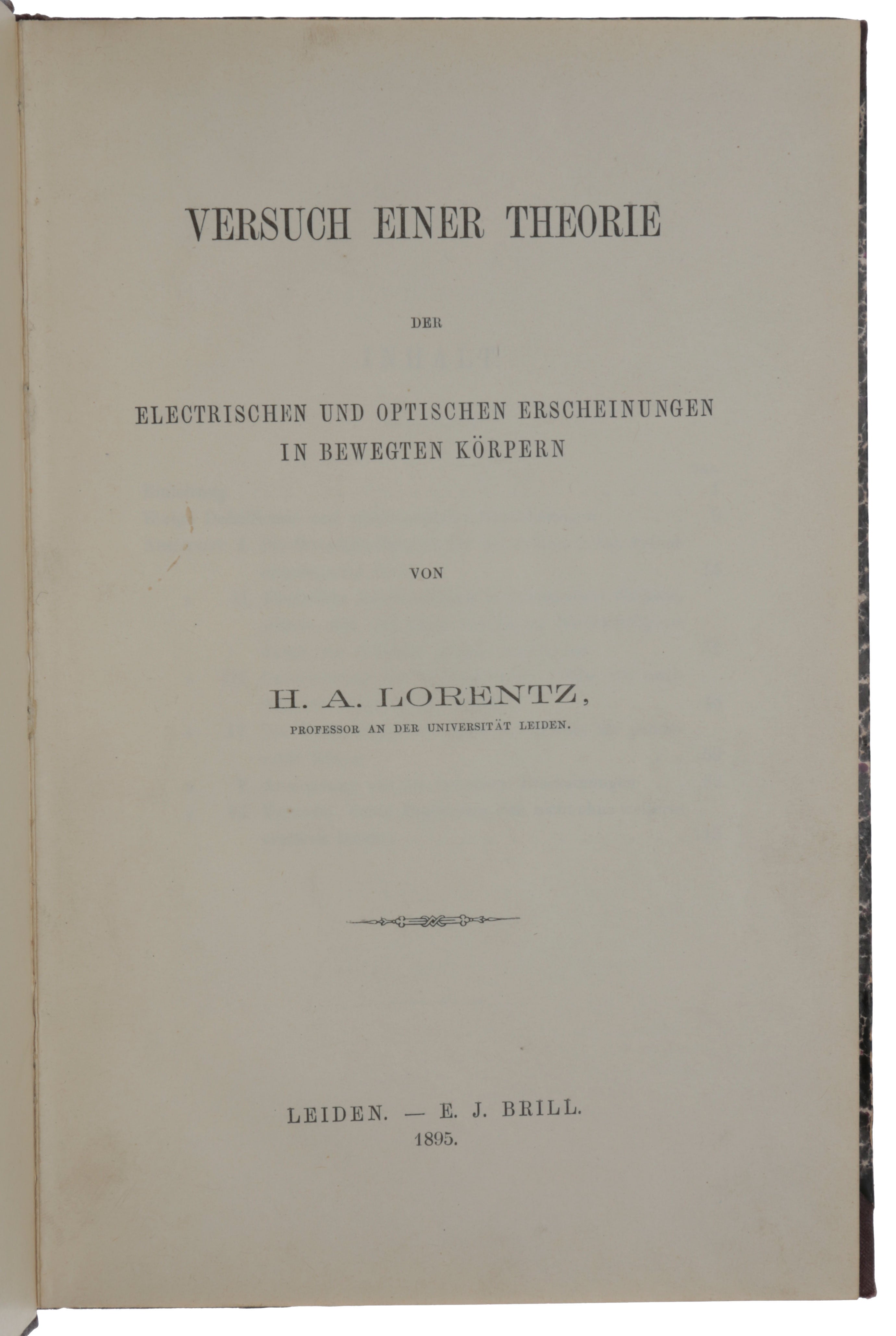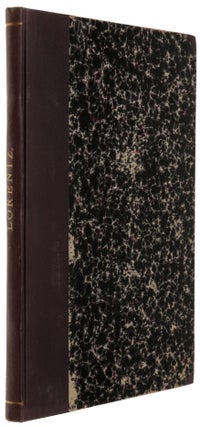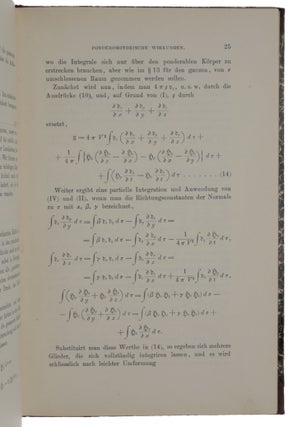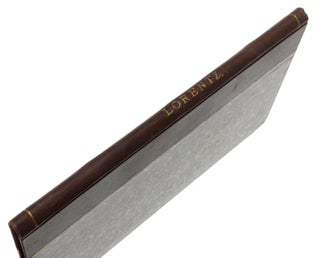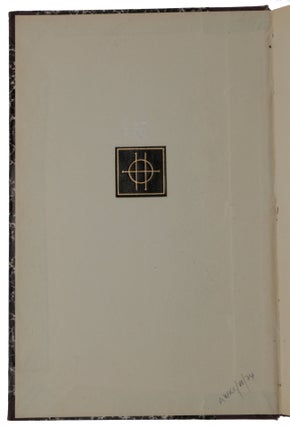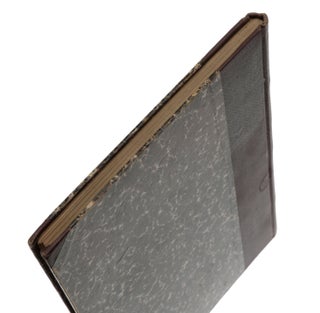Versuch einer Theorie der electrischen und optischen Erscheinungen in bewegten Körpern.
Leiden: E.J. Brill, 1895. First edition, the copy of The Garden Ltd., of Lorentz’s major work on the electrodynamics of moving bodies “which soon became a classic” (Schaffner, p. 503). It was in this work that he introduced the concept of ‘local time’, a “major discovery” (Hoffmann, p. 86), and the ‘length contraction hypothesis’, which together paved the way for the ‘Lorentz transformations’ he introduced in full in 1904. “Lorentz’s great achievement [for which he won the Nobel Prize in physics in 1902] was to unite the particulate view of electricity with Maxwell’s ether-borne, contiguously acting electromagnetic forces. This achievement was founded on Lorentz’s novel conception of the electromagnetic ether … The ether completely permeates matter, and it is not displaced when material bodies move through it. The sole connection between ether and matter occurs through the spherical charged particles, or electrons, that are contained in ponderable molecules. The displacement of one charged particle produces a change in the state of the ether, and this change is propagated outward at the speed of light, influencing a second particle at a later time” (McCormmach, pp. 47-48). In the Versuch, “Lorentz introduced his notion of a ‘local time’, which he utilized to obtain a ‘theorem of corresponding states.’ This theorem indicates that the earth’s motion through the aether will have no first-order effect whatever on experiments using terrestrial light sources” (Schaffner, p. 503), i.e., no effect if we neglect second and higher powers of v/c, where v is the speed of the body and c that of light. The local time was expressed in terms of the absolute time t by t – vx/c2: it was called ‘local’ because it depended on the body’s position x. The theorem of corresponding states allowed Lorentz to explain several physical effects which had posed difficulties for the ether theory, notably the aberration of light, the Doppler effect and the Fizeau experiment. But to deal with the null result of the Michelson-Morley experiment he had to make the further assumption that moving bodies are contracted in their direction of motion by a factor √1 – v2/c2 (a hypothesis also made, unknown to Lorentz, by the Irish physicist George Francis FitzGerald). In his 1905 paper on special relativity, the title of which echoes that of the present work (‘On the electrodynamics of moving bodies’), Einstein argued that the ether of the electron theory was unsuited for the development of a consistent electrodynamics but based his theory on the ‘Lorentz transformations’ that were foreshadowed in the Versuch. “Einstein was personally close to Lorentz for nearly 20 years, and he was intellectually close for an even longer time. He often tried out his latest ideas on Lorentz, whose opinion he valued above all others” (McCormmach, p. 41). Provenance: Haven O’More (1929-2008) (gilt leather book label of The Garden Ltd. on front paste-down). Born Richard Haven Moore in Austin, Texas, Haven O’More formed a magnificent library which he called ‘The Garden Ltd.’; its books were noted particularly for their fine condition. The collapse of a business partnership forced the sale of much of the collection at Sotheby’s on 9/10 November, 1989. As Nicolas Barker states in his Foreword to the auction catalogue, “The decision to choose the best authors and the best works, in the best available copies, is aptly demonstrated.” Maxwell’s idea of a single medium made of ether and matter implied that the ether was fully dragged by moving matter. This concept worked very well when applied to moving circuits and magnets, but it was less successful for optical phenomena. The first difficulty concerned the ‘stellar aberration’ discovered by the British astronomer James Bradley in 1728: the direction of observation of a fixed star appears to vary periodically over the course of a year. The corpuscular theory of light explained this effect simply by noting that the velocity of a light particle is the (vector) sum of its true velocity and the velocity of the earth. In the early 19th century, Thomas Young and August Fresnel showed that the same explanation worked in the wave theory of light if it was assumed that the ether was completely undisturbed by the motion of the earth through it, rather than being dragged along, and if the earth was moving at about 30 km/s relative to the ether. This posed a problem, as this relative motion of the earth and the ether should be detectable in a minute modification of the laws of optical refraction, but Fresnel’s friend François Arago had shown as early as 1818 that refraction by a prism was in fact unaffected by the earth’s annual motion. To explain this discrepancy, Fresnel proposed that the ether is stationary everywhere except in moving refractive media, in which it is partially dragged by an amount 1 – 1/n2 times the velocity of the medium relative to the ether, n being the refractive index of the medium. In 1850 Hippolyte Fizeau performed an experiment in which he split a light beam into two beams, had them travel through water moving in opposite directions, and measured the difference between the times taken by means of an interferometer. The result confirmed the partial dragging of light waves predicted by Fresnel. Maxwell, however, remained sceptical about the implications of Fizeau’s experiment. In a letter to William Huggins (10 June 1867) he wrote: “This experiment seems rather to verify Fresnel's theory of the ether; but the whole question of the state of the luminiferous medium near the earth, and of its connexion with gross matter, is very far as yet from being settled by experiment.” Maxwell’s reticence was justified twenty years later when Albert Michelson and Edward Morley carried out their famous experiment in which they compared the time taken by light to travel the same distance in two perpendicular directions. To the great surprise of the experts, Michelson and Morley found no difference between the times taken, which contradicted Fresnel’s theory. This was the confusing situation when Lorentz entered the field of electrodynamics, or rather re-entered it. “In his thesis in 1875 Lorentz applied Maxwell’s electromagnetic theory to the problem of the reflection and refraction of light. He approached the subject through Hermann von Helmholtz’s more general, action-at-a-distance equations rather than Maxwell’s contiguous-action ones. At the end of his thesis he detailed the enormously fruitful consequences he anticipated from the introduction of material molecules into electromagnetic theory. Maxwell’s original unification of light and electromagnetism was only the start; from the pervasive presence of electricity in nature, he argued, the union of electromagnetic theory and molecular theory promised to go far toward completing a synthesis of all branches of physical science. By 1878 Lorentz had arrived at an understanding close to that upon which his later electron theory was founded: charged harmonic oscillators exist within ponderable molecules, and the ether in intermolecular spaces retains the same properties as it has in a vacuum. “Through the 1880s Lorentz continued to be concerned with molecular physics, but chiefly in the context of the mechanical theory of heat. Prompted by Hertz’s critique of Maxwell’s theory as it applied to bodies in motion, Lorentz returned to the foundation of electrodynamics in the early 1890s … [In] 1892, he published his first statement of the electron theory [La theorie électromagnétique de Maxwell et son application aux corps mouvants]” (McCormmach, pp. 461-462). “Lorentz’s ether has no mechanical connection with matter, the interaction of the two occurs solely through small, ponderable, rigid bodies carrying positive or negative charges, which he assumed to be contained in all molecules of ordinary bodies. He referred to them in 1892 as ‘charged particles’, in 1895 as ‘ions’, and only after 1899 as ‘electrons’, from which his theory derived its permanent name. From a set of hypotheses about the stationary ether and electrons and from d’Alembert’s principle, Lorentz mechanically deduced [Maxwell’s] equations of the electromagnetic field and the equations of motion of an electron in the field [governed by the ‘Lorentz force’]. “In contrast to Maxwell and Hertz, Lorentz provided a clear, simple interpretation of electric charge and current and of their relation to the electromagnetic field. He explained that a body carries charge if it has an excess of one or the other kind of electrons, and an electric current in a conductor is a flow of electrons; correspondingly, a dielectric displacement in a non-conductor is a displacement of electrons from their equilibrium positions. The electrons of Lorentz’s theory create the electromagnetic field, the seat of which is the ether; the field in turn acts ponderomotively on ordinary matter through the electrons embedded in material molecules … By means of his concepts of a stationary ether and of electrons transparent to it, Lorentz constructed a consistent electrodynamics in which, at once, he rejected action at a distance and retained particulate electric fluids” (Jungnickel & McCormmach, p. 233). “The most important application of Lorentz’s basic equations [in La theorie électromagnétique de Maxwell] was his derivation of Fresnel’s drag coefficient, the outstanding test of a theory based on a stationary ether. Lorentz showed that his hypotheses were sufficient to explain the apparent dragging of the ether by bodies moving through it … “In Lorentz’s next major theoretical statement – his 1895 treatise on the influence of the earth’s motion on electrical and optical phenomena [the Versuch] – he abandoned his mechanical derivation, now regarding his basic equations as hypotheses” (McCormmach, p. 468). “This time he systematically went over the problem of the effects of the earth’s motion through the ether, which he had only touched on in 1892. Since the ether of the electron theory is not dragged by a body moving through it, the earth has an absolute velocity relative to it. The question arises whether or not the earth’s absolute velocity is detectable through optical or electromagnetic effects of the accompanying ether ‘drift’ or ‘wind’. The magnitude of the effects of the wind is measured theoretically by the ratio of the speed of the earth’s motion v to the speed of light c. The ratio is small for the earth, but not so small as to be beyond the reach of observation. “The effects of this wind, however, were not observed, and for his theory to be credible, Lorentz had to explain their absence. He showed that, according to the theory, an unexpected compensation of actions eliminates all effects of the ether wind to first-order approximation (neglecting terms involving the very much smaller second and higher powers of v/c). He analysed the absence of first-order effects of the ether wind in phenomena such as reflection, refraction, and interference with the aid of a formal ‘theorem of corresponding states’. The theorem asserts that to first-order accuracy, no experiments using terrestrial light sources can reveal the earth’s motion through the ether. By introducing transformations for the field magnitudes and spatial coordinates and a ‘local time’, Lorentz showed that to first-order approximation the equations describing a system in a moving reference frame are identical with those describing the corresponding system in a frame at rest in the ether, for which Maxwell’s equations hold exactly. “In more technical terms, Lorentz’s reasoning is as follows. To explain the absence of optical effects of the earth’s motion through the ether, Lorentz transformed Maxwell’s equations to axes attached to a moving dielectric. The equations he used for this purpose were the familiar Galilean equations from mechanics for the transformation of the spatial coordinates [i.e., replacing the spatial coordinate x by x – vt] supplemented by the transformation, his own, for the absolute time to the ‘local time’ [i.e., replacing t by t – vx/c2] of the dielectric moving with velocity v. To the first order in v/c, he showed that the equations that describe the passage of light in a moving dielectric … have the same form as Maxwell’s equations for a dielectric at rest, a correspondence with far-reaching consequences. If anywhere in the system at rest there is darkness [so all the electromagnetic field quantities are zero], it follows that there will be darkness at the corresponding place in the moving system [since the field quantities in the moving system are multiples of those in the stationary system]. Since a ray of light is determined by the absence of light at its boundaries, the same laws for the reflection and refraction of light rays must hold in the moving as in the stationary system, and for the same reason the alternating patterns of dark and light resulting from the interference of light must be the same in both systems” (Jungnickel & McCormmach, pp. 233-235). “Lorentz extended the application of his theory in 1895 to the three known optical effects of the motion of a source or observer. These were the aberration of starlight (change in the direction of light), Fizeau’s experiment (change in the speed of light) and the Doppler shift (change in the frequency of light). Lorentz derived the aberration and Doppler phenomena, and he improved upon his 1892 explanation of Fizeau’s experiment, refining his formula for the Fresnel drag coefficient by means of a dispersion theory. These three positive influences posed less difficulty for a stationary ether than did the numerous failures in other circumstances to observe an anticipated positive influence of motion. “In his 1895 Versuch Lorentz for the first time systematically reviewed the whole problem of ether-wind effects. He began with the case of the first-order electrical consequences of the earth’s motion. For example, a steady current moving with the earth cannot induce a current in another conductor moving with the earth; a charge distribution arises in the conducting circuit exactly cancelling the inductive effect, explaining Theodor des Coudres’ null measurements of the earth’s motion on the induction of closed currents … In another calculation, he proved that the earth’s motion through the ether should not affect electrostatic phenomena” (McCormmach, p. 469). “At the end of his treatise Lorentz acknowledged that his corresponding states theorem could not account for the second-order null effect of the Michelson-Morley experiment. He referred to his calculation earlier in the treatise of the influence of translation on the electric [i.e., electrostatic] force. If, he argued, the molecular forces are influenced in the same way as the electric force, then a ponderable body, such as the arms of Michelson’s interferometer, must contract in the direction of the earth’s motion in a ratio of √1 – v2/c2 in order that its molecular configuration remain in equilibrium” (McCormmach, p. 471). It is important to emphasize that the contraction hypothesis was not ad hoc, as is sometimes stated: Lorentz argued that the size of bodies is determined by the electrostatic forces acting between their molecules, and he had shown by means of Galilean coordinate transformations that these electrostatic forces themselves underwent a ‘contraction’, or reduction, in a stationary compared to a moving body, so that the stationary body ‘expands’ compared to the moving one. “Fully explained in the Versuch of 1895, Lorentz's theory gained broad recognition before the end of the century. Two other physicists, Joseph Larmor of Cambridge and Emil Wiechert of Königsberg, proposed similar theories in the same period. In the three theories, the basic idea was to hybridize Maxwell's theory with the corpuscular concept of electricity and to reduce every optic and electromagnetic phenomenon to the interactions between electric particles through a stationary ether. Besides the optics of moving bodies, these theories explained a variety of magnetic and magneto-optic phenomena, and of course retrieved the confirmed predictions of Maxwell’s theory. They benefited from the contemporary rise of an experimental microphysics, including the discoveries of X-rays (1895), radioactivity (1896), and the electron (1897). In 1896, the Dutch experimenter Pieter Zeeman revealed the magnetic splitting of spectral lines, which Lorentz immediately explained through the precession of the orbiting charged particles responsible for the lines. Being much lighter than hydrogen, these particles were soon identified with the corpuscle discovered in cathode rays by Emil Wiechert and Joseph John Thomson. Following Larmor’s terminology, this corpuscle became known as the electron and replaced the ions in Lorentz’s theory” (Darrigol, p. 9). “As early as 1895 [Henri Poincaré] had objected to the patchwork approach to the problem – Fresnel’s idea for explaining away the null results of first-order experiments to detect an ether wind, and a contraction of lengths for explaining away the second-order Michelson-Morley experiment … By 1904 second-order experiments different from the Michelson-Morley experiment were indeed also showing no sign of the earth’s absolute motion. Poincaré’s strictures against a patchwork approach greatly influenced Lorentz, who in 1904 published a key paper entitled ‘Electromagnetic phenomena in a system moving with any velocity less than that of light’ … In this paper Lorentz did avoid a patchwork approach to the explanation of all these results, as Poincaré had desired. Lorentz incorporated the FitzGerald-Lorentz contraction of lengths into his transformation formulas and made a corresponding change in the definition of the local time. This gave him what is now called the Lorentz transformations – a name bestowed on them by Poincaré in 1905” (Hoffmann, pp. 86-87). Lorentz was born at Arnhem, The Netherlands, on July 18, 1853. He entered the University of Leyden in 1870, obtained his B.Sc. degree in mathematics and physics in 1871, and returned to Arnhem in 1872 to become a night-school teacher, at the same time preparing for his doctoral thesis on the reflection and refraction of light. In 1875 he obtained his doctor’s degree, and only three years later he was appointed to the Chair of Theoretical Physics at Leyden, newly created for him. In spite of many invitations to chairs abroad, he always remained faithful to his Alma Mater. “An overwhelming number of honours and distinctions from all over the world were bestowed on Lorentz. International gatherings were presided over by him with exceptional skill, both on account of his amiable and judicious personality and his masterly command of languages. Until his death he was Chairman of all Solvay Congresses, and in 1923 he was elected to the membership of the ‘International Committee of Intellectual Cooperation’ of the League of Nations. Of this Committee, consisting of only seven of the world’s most eminent scholars, he became the President in 1925 … “It may well be said that Lorentz was regarded by all theoretical physicists as the world’s leading spirit, who completed what was left unfinished by his predecessors and prepared the ground for the fruitful reception of the new ideas based on the quantum theory … “Lorentz died at Haarlem on February 4, 1928” (nobel.org). Honeyman 2042; Norman 1388; PMM 378b; Poggendorff IV, 911; Roller/Goodman I, 130. Darrigol, ‘The genesis of the theory of relativity,’ Séminaire Poincaré 1 (2005), pp. 1-22. Hoffmann, Relativity and its Roots, 1983. Jungnickel & McCormmach, Intellectual Mastery of Nature. Theoretical Physics from Ohm to Einstein, Vol. 2, 1986. McCormmach, ‘H. A. Lorentz and the Electromagnetic View of Nature,’ Isis 61 (1970), pp. 459-497. Schaffner, ‘The Lorentz electron theory of relativity, American Journal of Physics 37 (1969), pp. 498-513.
8vo (224 x 146 mm), pp. [iv], [1], 2-138, [1]. Contemporary cloth-backed marbled boards. A very fine copy.
Item #4924
Price: $5,500.00

